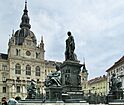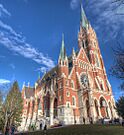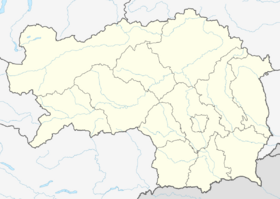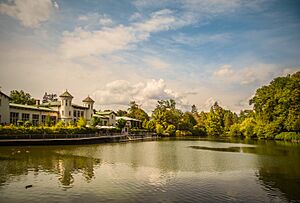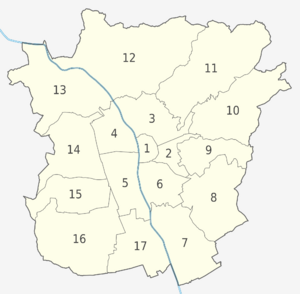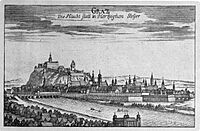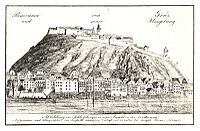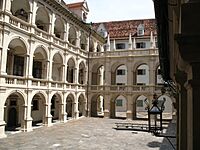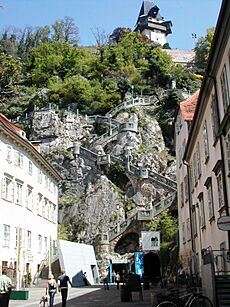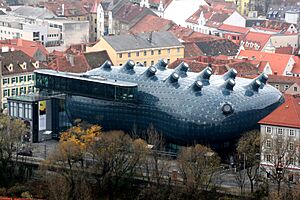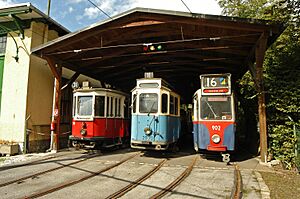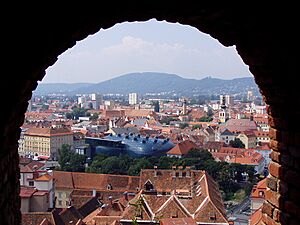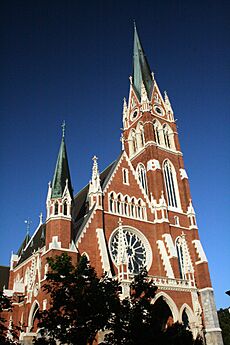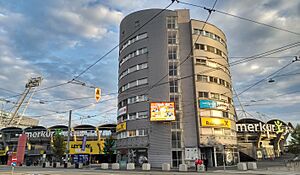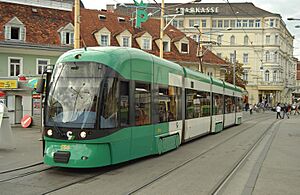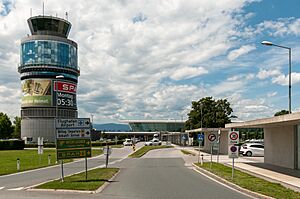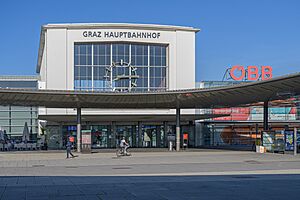Graz facts for kids
Quick facts for kids
Graz
|
|||||||||||||||
|---|---|---|---|---|---|---|---|---|---|---|---|---|---|---|---|
|
From top down, left to right: Main Square with City Hall, Typical street in Graz, Clock Tower on Castle Hill (Schlossberg), University of Technology, Church of the Sacred Heart of Jesus
|
|||||||||||||||
|
|||||||||||||||
| Country | |||||||||||||||
| Federal state | |||||||||||||||
| District | Statutory city | ||||||||||||||
| Elevation | 353 m (1,158 ft) | ||||||||||||||
| Population
(1 January 2024)
|
|||||||||||||||
| • Total | 303,270 | ||||||||||||||
| Demonym(s) | Grazer | ||||||||||||||
| Time zone | UTC+1 (CET) | ||||||||||||||
| • Summer (DST) | UTC+2 (CEST) | ||||||||||||||
| Postal code |
A-801x, A-802x, A-803x, A-804x, A-805x
|
||||||||||||||
| Area code | +43 316 | ||||||||||||||
| Vehicle registration | G | ||||||||||||||
| Website | www.graz.at | ||||||||||||||
|
|||||||||||||||
Graz is a super cool city in Austria! It's the capital of the federal state of Styria and the second-largest city in the whole country, right after Vienna. Imagine, over 300,000 people call Graz home!
Graz is also known as a big college and university city. It has four colleges and four universities, with more than 60,000 students. That's a lot of young people learning and living there!
The historic center of Graz, called Altstadt, is one of the best-preserved city centers in Central Europe. It's so special that in 1999, UNESCO added it to their list of World Heritage Sites. Later, in 2010, the beautiful Eggenberg Palace was also added. Graz was even named the Cultural Capital of Europe in 2003 and a City of Culinary Delights in 2008.
Contents
- What's in a Name? The History of Graz
- Exploring Graz: Its Location and Areas
- A Journey Through Time: The History of Graz
- People of Graz: Population and Diversity
- Weather in Graz: A Sunny Climate
- Exploring Graz: Top Sights and Attractions
- Culture and Arts in Graz
- Getting Around Graz: Transport Options
- Graz and the World: International Connections
- Famous People from Graz
- Images for kids
- See also
What's in a Name? The History of Graz
The name Graz, which used to be spelled Gratz or Grätz, probably comes from an old Slavic word, gradec, meaning "small castle". Long ago, some Slavic people built a small castle here. Later, Bavarian settlers arrived and mixed with the Slavs. The city's name first appeared in records in 1128.
Exploring Graz: Its Location and Areas
Graz is located in southeast Austria, right on both sides of the Mur River. It's about 150 kilometers (93 miles) southwest of Vienna. The city is the capital of Styria, a very green area with lots of forests, located on the eastern edge of the Alps.
Graz sits in a basin, surrounded by mountains and hills. The city center is about 353 meters (1,158 feet) high. The highest point nearby is Plabutsch mountain, at 754 meters (2,474 feet).
Nearby Towns and Villages
Graz has many neighbors! Here are some of the towns and villages that border it:
- To the north: Gratkorn, Stattegg, Weinitzen
- To the east: Kainbach bei Graz, Hart bei Graz, Raaba
- To the south: Gössendorf, Feldkirchen bei Graz, Seiersberg
- To the west: Attendorf, Thal, Judendorf-Straßengel
How Graz is Divided: Its Districts
Graz is split into 17 different areas called municipal districts (Stadtbezirke). Each district has its own unique feel.
- I. Innere Stadt
- II. St. Leonhard
- III. Geidorf
- IV. Lend
- V. Gries
- VI. Jakomini
- VII. Liebenau
- VIII. St. Peter
- IX. Waltendorf
- X. Ries
- XI. Mariatrost
- XII. Andritz
- XIII. Gösting
- XIV. Eggenberg
- XV. Wetzelsdorf
- XVI. Straßgang
- XVII. Puntigam
A Journey Through Time: The History of Graz
People have lived in the Graz area since the Copper Age, but the city as we know it started in the Middle Ages. German settlers called it "Bavarian Graz" to tell it apart from another "Slovenian Graz." Soon, the German Graz became the more important one.
In the 12th century, dukes made Graz an important trading center. Later, the powerful Habsburg family took over. In 1281, King Rudolph I gave Graz special rights.
Graz as a Royal City
During the 14th century, Graz became a home for a branch of the Habsburg family. The royals lived in the Schlossberg castle. From there, they ruled over a large area, including Styria, Carinthia, parts of Slovenia, and even parts of Italy.
In the 16th century, Italian architects and artists helped design many of Graz's buildings. The Landhaus, designed by Domenico dell'Allio, is a famous example. It was used as a government building.
Learning and Science in Graz
The University of Graz was started in 1585 by Archduke Karl II. It's the oldest university in the city. Famous scientists have lived and worked in Graz.
Johannes Kepler, a famous astronomer, lived in Graz for a short time starting in 1594. He studied astronomy while teaching math. Later, Nikola Tesla, a brilliant inventor, studied electrical engineering at the Polytechnic in 1875.
Graz and Its Defenses
Graz has a key location in the Mur valley, which made it a target for invaders. The city was attacked by the Hungarians in 1481 and the Ottoman Turks in 1529 and 1532. The Schlossberg castle was one of the few places that never fell to the Ottoman Turks.
Graz is also home to the provincial armory. This is the world's largest collection of old weapons and armor, with over 30,000 items! It has been kept safe since 1551.
Napoleon and the Schlossberg
In 1797, Napoleon's army took over Graz. In 1809, the city faced another attack from the French army. The Schlossberg fortress, defended by only about 900 men, bravely held off eight attacks from Napoleon's much larger army. However, they had to surrender when the French took Vienna.
After Austria's defeat, Napoleon ordered the fortress on the Schlossberg to be destroyed. But the people of Graz paid money to save two important parts: the bell tower and the famous clock tower (Uhrturm). The clock tower is now a symbol of Graz and a popular tourist spot!
People of Graz: Population and Diversity
Graz is a growing city. As of January 1, 2024, over 303,000 people live there. Many different nationalities call Graz home, making it a diverse and interesting place.
| Nationality | Population (1 January 2023) |
|---|---|
| 11,196 | |
| 10,305 | |
| 9,226 | |
| 7,598 | |
| 5,837 | |
| 4,723 | |
| 3,429 | |
| 3,354 | |
| 3,349 | |
| 3,141 | |
| 2,575 | |
| 2,553 | |
| 1,873 | |
| 1,823 | |
| 1,620 |
Weather in Graz: A Sunny Climate
Graz has a mild climate, often described as oceanic. Because it's located southeast of the Alps, the mountains protect it from strong westerly winds. This means Graz gets more sunshine than other Austrian cities like Vienna or Salzburg. It also has less wind and rain.
The city sits in a basin that opens to the south, making the climate warmer than you might expect. You can even find plants in Graz that usually grow much further south!
- Average yearly temperature: about 9.4°C (48.9°F)
- Average yearly rainfall: about 818 mm (32.2 inches)
- Average yearly sunshine: about 1,989 hours
| Climate data for Graz (Karl-Franzens University) 1991–2020, extremes 1961–2020 | |||||||||||||
|---|---|---|---|---|---|---|---|---|---|---|---|---|---|
| Month | Jan | Feb | Mar | Apr | May | Jun | Jul | Aug | Sep | Oct | Nov | Dec | Year |
| Record high °C (°F) | 21.0 (69.8) |
22.8 (73.0) |
25.1 (77.2) |
28.8 (83.8) |
34.1 (93.4) |
37.2 (99.0) |
38.1 (100.6) |
38.1 (100.6) |
32.0 (89.6) |
27.2 (81.0) |
23.0 (73.4) |
19.2 (66.6) |
38.1 (100.6) |
| Mean daily maximum °C (°F) | 3.9 (39.0) |
7.7 (45.9) |
11.6 (52.9) |
17.2 (63.0) |
20.8 (69.4) |
25.0 (77.0) |
25.9 (78.6) |
25.4 (77.7) |
21.2 (70.2) |
15.3 (59.5) |
9.2 (48.6) |
4.0 (39.2) |
15.6 (60.1) |
| Daily mean °C (°F) | 0.6 (33.1) |
2.7 (36.9) |
6.8 (44.2) |
11.6 (52.9) |
15.8 (60.4) |
19.4 (66.9) |
21.2 (70.2) |
20.8 (69.4) |
16.1 (61.0) |
11.3 (52.3) |
6.0 (42.8) |
1.1 (34.0) |
11.1 (52.0) |
| Mean daily minimum °C (°F) | −2.8 (27.0) |
−1.9 (28.6) |
1.7 (35.1) |
6.0 (42.8) |
9.9 (49.8) |
13.9 (57.0) |
15.1 (59.2) |
14.8 (58.6) |
11.1 (52.0) |
6.6 (43.9) |
2.7 (36.9) |
−1.8 (28.8) |
6.3 (43.3) |
| Record low °C (°F) | −19.5 (−3.1) |
−19.3 (−2.7) |
−17.2 (1.0) |
−5.5 (22.1) |
−1.3 (29.7) |
1.4 (34.5) |
6.3 (43.3) |
4.9 (40.8) |
0.8 (33.4) |
−6.4 (20.5) |
−10.8 (12.6) |
−18.3 (−0.9) |
−19.5 (−3.1) |
| Average precipitation mm (inches) | 19.8 (0.78) |
28.9 (1.14) |
34.6 (1.36) |
51.6 (2.03) |
93.2 (3.67) |
121.3 (4.78) |
124.1 (4.89) |
128.7 (5.07) |
93.8 (3.69) |
63.8 (2.51) |
54.4 (2.14) |
40.0 (1.57) |
854.2 (33.63) |
| Average snowfall cm (inches) | 9.1 (3.6) |
12.4 (4.9) |
5.2 (2.0) |
0.5 (0.2) |
0.0 (0.0) |
0.0 (0.0) |
0.0 (0.0) |
0.0 (0.0) |
0.0 (0.0) |
0.3 (0.1) |
4.7 (1.9) |
13.1 (5.2) |
45.3 (17.8) |
| Average precipitation days (≥ 1.0 mm) | 4.3 | 4.4 | 5.6 | 7.7 | 10.6 | 11.5 | 10.6 | 9.9 | 8.7 | 7.3 | 7.0 | 5.3 | 92.9 |
| Average snowy days (≥ 1.0 cm) | 11.5 | 7.8 | 3.5 | 0.3 | 0.0 | 0.0 | 0.0 | 0.0 | 0.0 | 0.1 | 1.6 | 7.5 | 32.3 |
| Average relative humidity (%) (at 14:00) | 68.7 | 59.1 | 53.0 | 49.6 | 53.0 | 54.5 | 53.4 | 55.2 | 58.1 | 63.0 | 70.8 | 73.1 | 59.3 |
| Mean monthly sunshine hours | 102.1 | 128.6 | 169.2 | 193.1 | 227.0 | 238.1 | 253.4 | 242.8 | 188.0 | 149.7 | 89.1 | 87.3 | 2,068.4 |
| Percent possible sunshine | 40.3 | 49.2 | 48.3 | 50.0 | 50.9 | 52.5 | 55.5 | 58.5 | 52.7 | 48.7 | 35.1 | 35.8 | 48.1 |
| Source: Central Institute for Meteorology and Geodynamics | |||||||||||||
Exploring Graz: Top Sights and Attractions
Graz was the Cultural Capital of Europe in 2003. For this special year, some cool new buildings were built. The Graz Museum of Contemporary Art (called Kunsthaus) looks like a giant blue bubble! The Island in the Mur is a floating platform on the Mur River with a cafe and playground.
Historic City Center: A UNESCO Treasure
The historic center of Graz is a UNESCO World Heritage Site. This means it's a very special place that needs to be protected. It has buildings from many different time periods and styles, all living together in harmony. You can see buildings from Gothic times all the way to modern ones.
Here are some of the most important sights in the historic center:
- Town Hall (Rathaus): The main city building.
- The Castle Hill (Schlossberg): A hill that stands over the city center. It used to have a fortress. You can get amazing views of Graz from here!
- The Clock Tower (Uhrturm): This is a symbol of Graz, located at the top of the Castle Hill.
- The New Gallery (Neue Galerie): An art museum.
- The Castle Hill funicular (Schlossbergbahn): A fun train that takes you up the Castle Hill.
- The Landhaus: A beautiful palace built in the Italian Renaissance style. It was designed by Domenico dell'Allio.
- The Armoury (Landeszeughaus): The biggest collection of old weapons and armor in the world!
- The Opera House (Opernhaus): A grand building for opera, ballet, and operetta. It's the second-largest opera house in Austria.
- The Theatre (Schauspielhaus): Graz's main theater for plays.
- The Cathedral (Dom): A rare example of Gothic architecture. Look for the "picture of plagues" painted in 1485, showing locusts, sickness, and Turkish invasions. It even has the oldest painted view of Graz!
- The Mausoleum of Emperor Ferdinand II: A very important building next to the cathedral.
- The City Park (Stadtpark): A lovely park in the middle of the city.
- The Castle (Burg): Built by Emperor Frederick III. It has a cool double-helix staircase! Today, it's where the Styrian government works.
- The Painted House (Gemaltes Haus): A building in Herrengasse 3 completely covered with colorful paintings from 1742.
- The Graz Museum of Contemporary Art (Kunsthaus): A modern art museum.
- The Island in the Mur (Murinsel): An artificial island in the Mur River.
Sights Beyond the City Center
- Eggenberg Palace (Schloss Eggenberg): A beautiful baroque palace on the western edge of Graz. It has amazing rooms and a museum. In 2010, it became part of the World Heritage site.
- The Mariatrost Basilica (Basilika Mariatrost): A large church on the eastern side of Graz.
- The Jesus's Heart Church (Herz-Jesu-Kirche): The biggest church in Graz, with the third-highest spire in Austria.
- The Calvary Hill (Kalvarienberg): In the Gösting area, with a 17th-century calvary and church.
- The Graz University Hospital: The largest hospital in Graz, known for its beautiful Jugendstil (Art Nouveau) architecture.
- The Gösting Ruin (Ruine Gösting): The remains of an old castle on a hilltop, offering great views.
Fun Places in the Greater Graz Area
- Österreichisches Freilichtmuseum Stübing: An open-air museum with old farmhouses from all over Austria.
- Lurgrotte: The biggest cave system in Austria.
- Lipizzanergestüt Piber: Where the famous Lipizzaner horses are bred.
- The Steirische Weinstraße: A wine-growing region south of Graz, sometimes called "Styrian Tuscany."
- Thermenregion: A spa region east of Graz.
- Riegersburg Castle: A strong fortress that was never captured!
Culture and Arts in Graz
Graz was the "European Capital of Culture" in 2003 and a UNESCO "City of Design" in 2011. It's a city that loves art and creativity!
Museums to Explore
Graz has many fantastic museums:
- Eggenberg Palace (Schloss Eggenberg): With its Old Gallery (art from Romanesque to Baroque), Coin Collection, and Archaeological Museum.
- Museum in the Palace: Learn about Styrian cultural history.
- New Gallery: See visual arts from the 19th and 20th centuries.
- Natural History Museum: Discover botany, mineralogy, and zoology.
- Graz City Museum (Stadtmuseum Graz)
- Museum of Contemporary Art (Kunsthaus)
- City Park Forum (Forum Stadtpark): More contemporary art.
- Camera Austria: Focuses on modern photography.
- Armoury (Landeszeughaus): The world's largest collection of medieval armor and weapons.
- Folklore Museum (Volkskundemuseum): Learn about local traditions.
- Diocesan Museum (Diözesanmuseum): About the Roman Catholic Church.
- Artists House (Künstlerhaus): A place for contemporary visual arts.
- Literature House (Literaturhaus): About modern German literature.
- Museum of Perception (Museum der Wahrnehmung): Explore your senses!
- Children's Museum Frida & Fred (Kindermuseum Frida & Fred): A museum just for kids!
- Tram Museum: See 40 historic trams, some from 1873!
- Kriminalmuseum: A museum about criminology.
- Aviation Museum (Luftfahrtmuseum): Located at Graz Airport.
- Hanns Schell Collection: The world's largest collection of keys and locks.
- Austrian Sculpture Park: Seven hectares of modern sculptures.
- Botanical Garden of Graz: Beautiful glass houses and gardens.
Architecture: Buildings of Graz
The center of Graz is known for its old residential buildings and churches. In the outer parts of the city, you'll see more modern buildings from the second half of the 20th century.
Before Graz became the European Capital of Culture in 2003, many new projects were completed. These include the Stadthalle (a big space for events), the Children's Museum, the Helmut-List-Halle, the Museum of Contemporary Art (Kunsthaus), and the Island in the Mur (Murinsel).
Tallest Buildings in Graz
Here are some of the tallest buildings in Graz:
| Name or Address | Built | Use | Height (m) | Floors | |
|---|---|---|---|---|---|
| 1. | Jesus's Heart Church (Herz-Jesu-Kirche) | 1887 | Church | 109 | |
| 2. | Elisabeth Building (Elisabeth Hochhaus) | 1964 | Residential | 75 | 25 |
| 3. 4. | Kärntner Straße 212, Liebenauer Hauptstraße 309 | 1968 and 1955 | Residential | 69 | 21 |
| 5. | Franciscan Church (Franziskanerkirche) | 1240 | Church | 69 | |
| 6. | Alpha Tower | 1960/2 floors added in 2015 | Residential | 67 | 21 |
| 7. | Telekom Austria Tower | 1960s | Office | 65 | 15 |
| 8. | Basilica Mariatrost | 1724 | Church | 61 | |
| 9. | Styria Media Center | 2014 | Office | 60 | 15 |
| 10. | Science Tower | 2017 | Office | 60 | 12 plus skygarden |
Sports in Graz
Graz is home to several sports teams!
- SK Sturm Graz is the city's main football (soccer) club. They have won the Austrian championship four times!
- Grazer AK also won an Austrian championship.
- In ice hockey, ATSE Graz won the Austrian Hockey League in 1975 and 1978. Graz 99ers also play in the top division.
- UBSC Raiffeisen Graz plays in the Austrian Basketball League.
- The Graz Giants play American Football.
Graz even tried to host the 2002 Winter Olympics in 1995!
Styriarte: A Music Festival
Graz hosts an annual festival of classical music called Styriarte. It started in 1985 and brings amazing music to different places in Graz and the surrounding area.
Getting Around Graz: Transport Options
It's easy to get around Graz without a car! The city has a great public transport system. There's a big bus network and a tram network with six lines. Four tram lines go through the underground station at the main train station (Hauptbahnhof) and into the city center. There are also night buses on weekends and holidays.
You can also take the Castle Hill funicular or the Castle Hill lift (Schlossberg lift) to reach the Castle Hill.
From the main train station (Hauptbahnhof), you can catch trains to most of Styria and many major cities like Vienna, Salzburg, Innsbruck, Maribor (Slovenia), Zagreb (Croatia), and Munich (Germany). Trains to Vienna leave every hour! Many local train stations have been updated and are now part of the Styria S-Bahn, a commuter train service connecting Graz with its suburbs.
Graz Airport is about 10 kilometers (6 miles) south of the city. You can get there by bus, train, taxi, or car.
Graz and the World: International Connections
Graz has "twin city" relationships with many cities around the world. This means they share culture and ideas!
 Montclair, New Jersey, United States, since 1950
Montclair, New Jersey, United States, since 1950 Coventry, England, United Kingdom, since 1957
Coventry, England, United Kingdom, since 1957 Groningen, Netherlands, since 1964
Groningen, Netherlands, since 1964 Darmstadt, Germany, since 1968
Darmstadt, Germany, since 1968 Trondheim, Norway, since 1968
Trondheim, Norway, since 1968 Pula, Croatia, since 1972
Pula, Croatia, since 1972 Trieste, Italy, since 1973
Trieste, Italy, since 1973 Timișoara, Romania, since 1982
Timișoara, Romania, since 1982 Maribor, Slovenia, since 1987
Maribor, Slovenia, since 1987 Pécs, Hungary, since 1989
Pécs, Hungary, since 1989 Dubrovnik, Croatia, since 1994
Dubrovnik, Croatia, since 1994 Ljubljana, Slovenia, since 2001
Ljubljana, Slovenia, since 2001 Saint Petersburg, Russia, since 2001 (On-Hold, since March 2022)
Saint Petersburg, Russia, since 2001 (On-Hold, since March 2022)
Graz also has other friendly connections with cities like:
 Niš, Serbia
Niš, Serbia Banja Luka, Bosnia and Herzegovina
Banja Luka, Bosnia and Herzegovina
Famous People from Graz
Many interesting people have lived in Graz!
- Peter Handke (born 1942), a Nobel Prize winner for literature.
- Ferdinand II (1578-1637), a Holy Roman Emperor.
- Wladimir Köppen (1846-1940), a geographer and expert on climate.
- Ludwig Boltzmann (1844–1906), a physicist and university professor.
- Archduke John of Austria (1782–1859), a military leader and modernizer.
- Archduke Franz Ferdinand of Austria (1863–1914), an important royal figure.
- Nicolaus Harnoncourt (1929–2016), a famous conductor of classical music.
- Johannes Kepler (1571–1630), a German astronomer and math teacher.
- Otto Loewi (1873–1961), a Nobel Prize-winning physiologist.
- Marisa Mell (1939–1992), an actress born and raised in Graz.
- August Musger (1868–1929), who invented slow motion cinema!
- Johann Puch (1862–1914), an inventor and mechanic.
- Erwin Schrödinger (1887–1961), a Nobel Prize-winning physicist.
- Arnold Schwarzenegger (born 1947), a famous actor and former governor of California. He grew up near Graz.
- Nikola Tesla (1856–1943), a Serbian-American inventor who studied in Graz.
- Johann Bernhard Fischer von Erlach (1656–1723), a famous Baroque architect.
- Jochen Rindt (1942–1970), the first Austrian Formula One champion.
- Thomas Vanek (born 1984), a professional ice hockey player.
Images for kids
See also
 In Spanish: Graz para niños
In Spanish: Graz para niños


